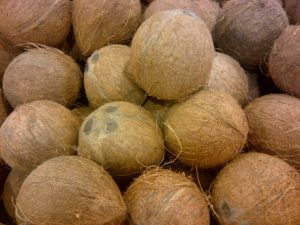
The mature, brown husked coconut is the third stage of maturation, and offers a nutty, sweet flavor. The fresh meat of the coconut offers iron, potassium, protein, fiber, other various minerals and contains saturated fats. Coconut helps keep you feeling full between meals without carrying too much caloric value, and helps regular blood pressure and keep sodium levels in check.
Selection
Indicators of a good coconut are not always reliable, but in general these are some things you should The eyes, or indents should be uniformly brown and firm. The coconut should be heavy for their size and have a distinct sloshing sound, indicating it has good amount of juice internally. Husk should be dry and without mold.
Preparation
For ease in opening, puncture the eyes of the coconut with a screwdriver and drain the juice. Then heat the coconut under hot running water or place in a 375 degree oven for 20 minutes. Fault lines will appear on the warmed coconut. Hold the hot coconut in a cloth and place over a large bowl. Hit the fault lines with a hammer or mallet. Save the liquid, remove the meat, and peel off brown outer pieces with a small knife. To prepare thick coconut milk, wrap grated coconut in cheesecloth and place over a bowl. Pour one-half cup warm water over and squeeze liquid into the bowl. This can be done multiple times resulting in different thickness for the milk/cream. Use the milk and meat in fruit salads, puddings, cakes, cookies, custards, pies and other baked goods. Tint grated coconut with food coloring to make a colorful sweet topping. To store, whole coconuts will keep at room temperature for two weeks. For longer storage, refrigerate. Grated coconut will keep two weeks refrigerated in a glass jar. Place a whole hot chile in with the coconut to keep it from going bad. The outer shell, or husk, of the coconut can be use used as a starter for charcoal when grilling. Source: Specialty Produce.